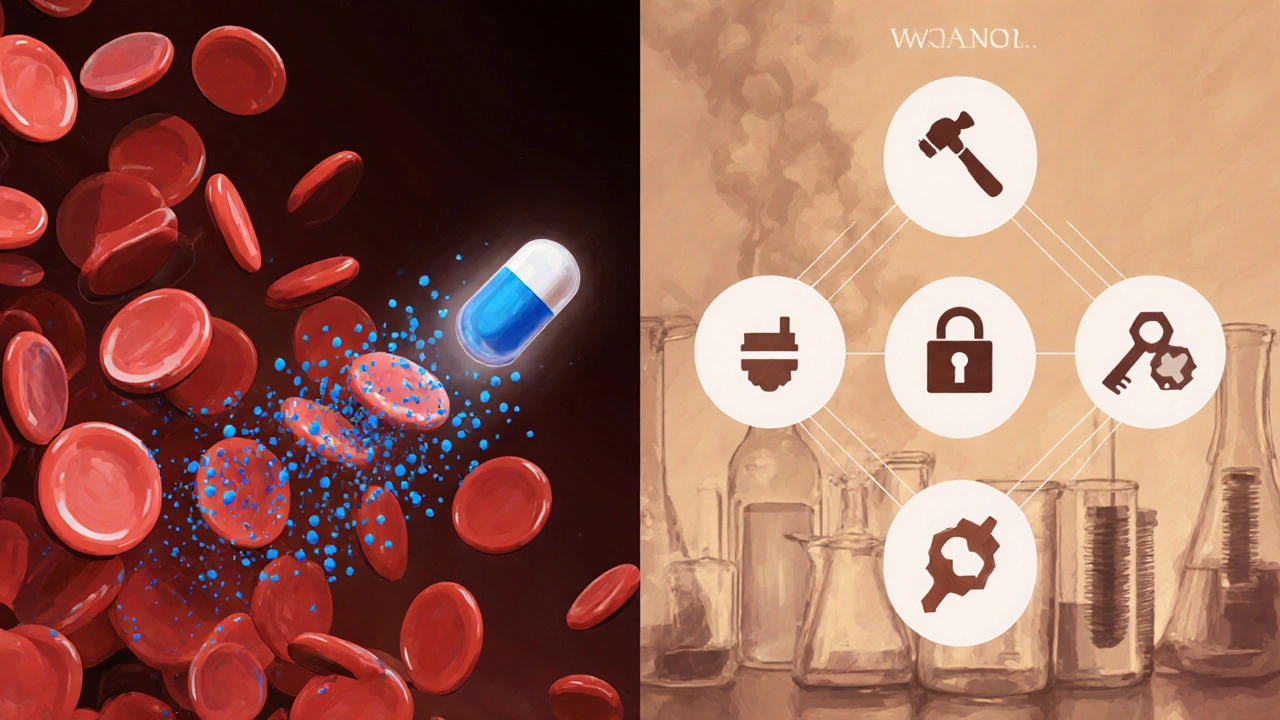Antiplatelet Drug Comparison Tool
Select a drug and click "Compare Selected Drug" to see detailed information.
Clinical Decision Points
- Stroke Prevention: Dipyridamole + Aspirin recommended after TIA or minor stroke
- Post-CABG: Dipyridamole improves graft patency when combined with aspirin
- ACS/PCI: Ticagrelor or Prasugrel preferred for rapid onset and consistency
- Renal Impairment: Dipyridamole is safer than dabigatran/rivaroxaban
Key Takeaways
- Dipyridamole works by raising cyclic AMP in platelets, making it useful mainly after cardiac surgery or in combination therapy.
- Aspirin and Clopidogrel are the first‑line oral antiplatelet agents for most patients because of proven outcomes and simple dosing.
- Ticagrelor and Prasugrel offer faster, more consistent platelet inhibition but carry higher bleeding risk.
- When choosing an alternative, consider the clinical setting, drug interactions, renal function, and patient adherence.
- Combination therapy (e.g., Dipyridamole+Aspirin) can be effective for stroke prevention but increases bleeding risk.
Patients and clinicians often wonder how Dipyridamole a phosphodiesterase inhibitor that prevents platelet aggregation by raising intracellular cAMP levels stacks up against the more familiar antiplatelet agents on the market. Below is a step‑by‑step look at the major alternatives, when each shines, and hidden pitfalls you might miss.
Why Dipyridamole Exists in the Antiplatelet Toolbox
Dipyridamole was first approved in the 1970s for preventing blood clots after heart bypass surgery. Its mechanism-blocking the uptake of adenosine and inhibiting phosphodiesterase-gives it a dual effect: it dilates coronary vessels and keeps platelets from clumping. Because it works best when combined with another agent (most often low‑dose aspirin), it isn’t a stand‑alone solution for acute coronary syndrome but remains valuable for certain stroke‑prevention protocols and for patients who cannot tolerate stronger agents.
Major Antiplatelet Alternatives
Here are the eight most frequently compared drugs, each with its own niche.
- Aspirin an irreversible COX‑1 inhibitor that blocks thromboxane A2 production
- Clopidogrel a P2Y12 receptor antagonist that requires hepatic activation
- Ticagrelor a reversible P2Y12 inhibitor with rapid onset
- Prasugrel a thienopyridine similar to clopidogrel but with more consistent activation
- Warfarin a vitamin K antagonist that interferes with clotting factor synthesis
- Heparin an injectable anticoagulant that enhances antithrombin activity
- Dabigatran a direct thrombin inhibitor taken orally
- Rivaroxaban a direct factor Xa inhibitor used for thromboprophylaxis

Head‑to‑Head Comparison Table
| Drug | Mechanism | Typical Indication | Usual Dose | Onset (hrs) | Major Side‑effects |
|---|---|---|---|---|---|
| Dipyridamole | Phosphodiesterase inhibition & adenosine uptake block | Post‑CABG graft patency, secondary stroke prevention (with aspirin) | 75‑200mg PO qid | 2‑4 | Headache, dizziness, GI upset |
| Aspirin | Irreversible COX‑1 inhibition | Primary/secondary CAD, stroke prevention | 81‑325mg PO daily | 0.5‑1 | Gastro‑intestinal bleeding, dyspepsia |
| Clopidogrel | P2Y12 ADP receptor antagonist (pro‑drug) | ACS, stent thrombosis prophylaxis | 75mg PO daily | 4‑6 | Bleeding, rare dermatologic reactions |
| Ticagrelor | Reversible P2Y12 inhibitor | ACS, high‑risk PCI | 90mg PO bid | 0.5‑2 | Dyspnea, bleeding |
| Prasugrel | Thienopyridine P2Y12 antagonist | PCI with stent placement | 10mg PO daily | 2‑4 | Bleeding, especially in < 60yr with < 30kg |
| Warfarin | VitaminK antagonist | AFib, mechanical valves | 2‑10mg PO daily (INR‑guided) | 24‑48 | Bleeding, skin necrosis |
| Heparin | Enhances antithrombin III | Hospital‑based VTE prophylaxis | 5000U SC q8h | Immediate | Heparin‑induced thrombocytopenia |
| Dabigatran | Direct thrombin inhibitor | Non‑valvular AFib | 150mg PO bid | 2‑4 | Gastro‑intestinal bleeding |
When Dipyridamole Beats the Rest
Even though newer P2Y12 blockers dominate acute coronary care, dipyridamole still has two sweet spots:
- Stroke prevention after a transient ischemic attack (TIA): The European Stroke Prevention Study showed that dipyridamole + aspirin reduced recurrent stroke risk by ~23% compared with aspirin alone.
- Graft patency post‑coronary artery bypass grafting: A meta‑analysis of 12 trials found a 15% lower occlusion rate when dipyridamole was added to aspirin.
In both scenarios, the drug’s ability to boost cAMP adds a modest antiplatelet effect without the high bleeding rates seen with potent P2Y12 inhibitors.
Why Clinicians Reach for the Other Agents
For most patients with coronary artery disease, the evidence base for aspirin, clopidogrel, ticagrelor, and prasugrel is far larger. They have clear outcome data from large RCTs (e.g., PLATO for ticagrelor, TRITON‑TIMI 38 for prasugrel). These drugs are also easier to dose-once‑daily for aspirin and clopidogrel, twice‑daily for ticagrelor-whereas dipyridamole requires four doses a day, which hurts adherence.
When a fast, reliable antiplatelet effect is needed (like during an PCI), clinicians prefer ticagrelor or prasugrel because they reach peak inhibition within an hour and are not affected by CYP2C19 polymorphisms that can make clopidogrel ineffective in 30% of the population.
Safety Trade‑offs: Bleeding vs. Efficacy
Bleeding risk is the biggest factor in choosing an alternative. Here’s a quick rule‑of‑thumb:
- Low bleeding tolerance (elderly, prior GI bleed): Aspirin + dipyridamole or low‑dose clopidogrel.
- High thrombotic risk (recent stent, ACS): Ticagrelor or prasugrel, accepting higher bleed rates.
- Renal impairment: Avoid dabigatran and adjust dose of rivaroxaban; dipyridamole is mainly hepatically cleared, so it’s safer for kidneys.

Drug Interactions You Can’t Ignore
Each alternative brings its own interaction nightmare:
- Clopidogrel is deactivated by strong CYP2C19 inhibitors (e.g., fluconazole, omeprazole). Switching to ticagrelor bypasses that.
- Warfarin interacts with many foods and antibiotics; dipyridamole does not affect INR.
- Heparin requires monitoring for PF4 antibodies; dipyridamole has no such lab burden.
Always review a patient’s medication list before committing to a regimen.
Choosing the Right Regimen - A Quick Decision Tree
- Is the goal primary/secondary prevention of cardiovascular events in a stable patient?
→ Aspirin alone (low‑dose) is usually enough unless stroke risk is high. - Is the patient post‑stroke or TIA and can tolerate combination therapy?
→ Aspirin+Dipyridamole. - Is the patient undergoing PCI with a drug‑eluting stent?
→ Dual antiplatelet therapy: Aspirin+Clopidogrel (standard) or Aspirin+Ticagrelor/Prasugrel (high risk). - Does the patient have significant bleeding risk or contraindication to aspirin?
→ Consider Clopidogrel monotherapy or low‑dose dipyridamole.
Practical Tips for Patients
- Take dipyridamole with food to reduce stomach upset.
- Never skip doses; the four‑times‑daily schedule can be tricky.
- Report any new headache, visual changes, or easy bruising to your doctor.
- Keep a medication list handy when seeing new specialists-a lot of the alternatives share the same “antiplatelet” label but behave very differently.
Frequently Asked Questions
Can I replace my aspirin with dipyridamole?
Usually not. Dipyridamole alone is weaker than aspirin for most cardiovascular events. Doctors typically prescribe them together only for specific stroke‑prevention protocols.
What’s the biggest advantage of ticagrelor over clopidogrel?
Ticagrelor works faster, doesn’t need metabolic activation, and provides more consistent platelet inhibition, which matters after an acute coronary event.
Is dipyridamole safe for people with asthma?
Dipyridamole can cause bronchospasm in very sensitive individuals, so doctors usually avoid it in uncontrolled asthma.
How do I know if I’m a poor metabolizer of clopidogrel?
Genetic testing for CYP2C19 variants can identify poor metabolizers. If you’ve had a stent placed and are on clopidogrel with recurrent events, ask your cardiologist about testing.
Can I take dipyridamole with warfarin?
Yes, there’s no direct interaction, but both increase bleeding risk, so your doctor will monitor INR more closely.


Sebastian Miles
October 11, 2025 AT 13:24Dipyridamole’s PDE inhibition raises platelet cAMP, giving a modest antiplatelet effect that’s especially useful post‑CABG or with aspirin for stroke prevention.
Harshal Sanghavi
October 18, 2025 AT 12:04Sure, because who doesn’t love popping four pills a day, right?
chris macdaddy
October 25, 2025 AT 10:44Yo, if you’re looking at dipyridamole, remember it’s not a stand‑alone hero – you’ll wanna pair it w/ low‑dose aspirin to really get that stroke‑prevention punch. Also, take it with meals to dodge the stomach upset, and don’t forget the qid schedule, or you’ll lose the benefit. Stay steady and you’ll see the graft patency numbers improve.
Moumita Bhaumik
November 1, 2025 AT 09:24Don’t be fooled by the pharma hype – they push dipyridamole as a “miracle combo” while hiding the fact that it can mask bleeding risks and keep you on a never‑ending pill regimen.
Sheila Hood
November 8, 2025 AT 08:04Clinically, dipyridamole adds a 2‑4 hour onset and modest platelet inhibition, which is about as exciting as watching paint dry in a waiting room.
Melissa Jansson
November 15, 2025 AT 06:44While the consensus crowns ticagrelor as the epitome of rapid P2Y12 blockade, one could argue that the so‑called “gold standard” is merely a marketing ploy, and that dipyridamole’s unique adenosine‑mediated vasodilation offers a mechanistic elegance overlooked by the hype‑driven hierarchy.
Max Rogers
November 22, 2025 AT 05:24Just a quick note: “dipyridamole” should be capitalized at the start of a sentence, and “post‑CABG” is hyphenated correctly; otherwise, the content reads well.
Louie Hadley
November 29, 2025 AT 04:04I hear both sides – the newer P2Y12 inhibitors bring speed, but dipyridamole brings a different pharmacologic angle that can be valuable in specific niches without raising the same bleeding concerns.
Ginny Gladish
December 6, 2025 AT 02:44The comparative table is succinct, yet it omits key pharmacokinetic parameters such as hepatic metabolism pathways and half‑life variability, which are essential for individualized therapy decisions.